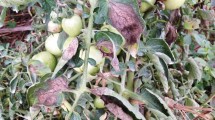Abstract
The most serious symptom of Botrytis cinerea in tomatoes grown in greenhouses is stem rotting. Lesions on the stem may result from direct infection or from progression of the rot along infected leaves, until infection approaches the stem. In a set of experiments conducted in commercial greenhouses, an experimental greenhouse and growth chambers, the significance of the two types of stem infections was studied. In non-heated greenhouses most of the stem lesions originated from progression of the pathogen along infected petioles. The rate at which B. cinerea had progressed on infected petioles was 0.3–0.5 cm/day, an average of ca. 6 weeks was needed for a leaf infection to approach the stem. Application of Trichoderma harzianum T39 extended this time by 1–2 weeks and application of chemical fungicides by 3 weeks. Influence of the environment on the progression of B. cinerea along infected petioles was then determined. Within range of 5–30 °C, the higher the temperature, the more rapid was the rate of disease progression. The fungus progressed more rapidly on tomato petioles incubated at high vapour pressure deficit (VPD) rather than at low VPD. The source-sink relationship of the plant governed the rate of B. cinerea progression along the petioles as well: it was more rapid when the source was restricted (by shading) and slower when the sink was restricted (by removal of flowers and small fruits). The possibility that sanitation of infected leaflets would reduce the incidence of stem rotting was examined in two experiments. In plots not treated with a fungicide, the sanitation treatment substantially decreased the incidence of stem lesions and this treatment was as effective as weekly application of chemical fungicides.
Similar content being viewed by others
References
Berg van den L and Lentz CP (1968) The effect of relative humidity and temperature on survival and growth of Botrytis cinerea and Sclerotinia sclerotiorum. Journal of Botany 46: 1477–1481
Chastagner GA, Ogawa JM, Manji BT and Matsumoto TT (1977) Botrytis cinerea stem canker development and control on vineripe tomatoes in California. Proceedings of the American Phytopathological Society 4: 114
Dik AJ and Koning ANM (1996) Influence of climate on epidemiology of Botrytis cinerea in cucumber. XIth International Botrytis Symposium, Wageningen, the Netherlands. p. 46
Eden MA, Hill RA, Beresford R and Stewart A (1996) The influence of inoculum concentration, relative humidity, and temperature on infection of greenhouse tomatoes by Botrytis cinerea. Plant Pathology 45: 795–806
Elad Y, Gullino ML, Shtienberg D and Aloi C (1995) Managing Botrytis cinerea on tomatoes in greenhouses in the Mediterranean. Crop Protection 14: 105–106
Elad Y and Shtienberg D (1995) Botrytis cinerea in greenhouse vegetables: chemical, cultural, physiological and biological controls and their interaction. Integrated Pest Management Reviews 1: 15–29
Elad Y, Shtienberg D, Yunis H and Mahrer Y (1992) Epidemiology of grey mould in vegetable greenhouses. In: Verhoeff K, Malathrakis NE and Williamson B (eds) Recent Advances in Botrytis Research. (pp. 147–158) Pudoc Scientific Publishers, Wageningen, the Netherlands
Gullino ML, Aloi C and Garibaldi A (1991) Integrated control of grey mould of tomato. In: Albdjes R (ed) Integrated Control in Protected Crops under Mediterranean Climate (pp. 211–215) WPRS Bull. No. 137
Hyre RA (1972) Effect of temperature and light on colonization and sporulation of the Botrytis pathogen on geranium. Plant Disease Reporter 56: 126–130
Jarvis WR (1980) Epidemiology. In: Coley-Smith JR, Verhoeff K and Jarvis WR (eds) The Biology of Botrytis. (pp. 219–250). Academic Press, London
Jarvis WR (1989) Managing diseases in greenhouse crops. Plant Disease 73: 190–194
Jarvis WR (1992) Managing Diseases in Greenhouse Crops. American Phytopathological Society Press, St. Paul, MN USA. 288 pp.
Morgan WM (1985) Influence of energy-saving night temperature regimes on Botrytis cinerea in an early-season glasshouse tomato crop. Crop Protection 4: 99–110
O'Neill TM (1994) Resurgence of tomato stem Botrytis. Grower 122: 54–55
O'Neill TM, Niv A, Elad D and Shtienberg D (1996) Biological control of Botrytis cinerea on tomato stem wounds with Trichoderma harzianum. European Journal of Plant Pathology 102: 635–643
O'Neill TM, Shtienberg D and Elad Y (1997) Effect of some host and microclimate factors on infection of tomato stems by Botrytis cinerea. Plant Disease 81: 36–40
Sharabani G, Shtienberg D, Elad Y, Dinoor A and Yunis H (1996) Development of gray mold in sweet basil. Phytoparasitica 24: 140.
Shtienberg D and Elad Y (1997) Incorporation of weather forecasting to integrated, chemical-biological management of Botrytis cinerea. Phytopathology 87: 332–340
Verhoeff K (1965) Studies of Botrytis cinerea in tomatoes. Mycelial development in plants growing in soil with various nutrient levels, as well as in internodes of different age. Netherlands Journal of Plant Pathology 71: 167–175
Verhoeff K (1967) Studies on Botrytis cinerea in tomatoes: influence of methods of deleafing on the occurrence of stem lesions. Netherlands Journal of Plant Pathology 73: 117–120
Verhoeff K (1968) Effect of soil nitrogen level and methods of deleafing upon the occurrence of Botrytis cinerea under commercial conditions. Netherlands Journal of Plant Pathology 74: 184–194
Wilson AR (1962) Grey mold of tomato. Reports of the Scottish Horticultural Research Institute 9: 74–75
Wilson AR (1963) Grey mold of tomato: Etiology of stem infection by Botrytis cinerea. Reports of the Scottish Horticultural Research Institute 10: 79–81
Winspear KW, Postlethwaite JD and Cotton RF (1970) The restriction of Cladosporium fulvum and Botrytis cinerea, attacking glasshouse tomatoes, by automatic humidity control. Annals of Applied Biology 65: 75–83
Yunis H, Elad Y and Mahrer Y (1990) Effects of air temperature, relative humidity and canopy wetness on grey mould of cucumbers in unheated greenhouses. Phytoparasitica 18: 203–215
Author information
Authors and Affiliations
Rights and permissions
About this article
Cite this article
Shtienberg, D., Elad, Y., Niv, A. et al. Significance of leaf infection by Botrytis cinerea in stem rotting of tomatoes grown in non-heated greenhouses. European Journal of Plant Pathology 104, 753–763 (1998). https://doi.org/10.1023/A:1008690925443
Issue Date:
DOI: https://doi.org/10.1023/A:1008690925443




